Night exercise has gained popularity as more people are incorporating physical activity into their busy schedules. However, engaging in vigorous workouts during evening hours may come with unexpected health risks that should not be overlooked. In this article, we will explore the potential dangers associated with exercising at night, shedding light on how it may increase the risk of early death.
Key Takeaways:
- Exercising at night disrupts natural sleep cycles and can lead to sleep disturbances.
- Night exercise intensifies cardiovascular strain, raising the risk of heart-related complications.
- Hormonal imbalances may occur due to late-night workouts, potentially impacting overall health.
- Engaging in exercise in insufficiently lit environments increases the chances of injuries and accidents.
- The paradox of nightly physical activity and its potential risks should be considered when deciding on the ideal time for exercise.
Disruption of Natural Sleep Cycles
Exercising at night can disrupt the body’s natural sleep-wake cycle, known as the circadian rhythm. Understanding the impact of night exercise on this essential biological process is crucial to grasp the potential risks it poses.
Understanding Circadian Rhythms and Night Exercise
The circadian rhythm is a 24-hour internal clock that regulates various physiological processes, including sleep-wake cycles, hormone production, and metabolic functions. Disruption of this rhythm can have significant implications for health and well-being.
Engaging in exercise at night can confuse the body’s internal clock, as it signals a period of wakefulness and activity when the body is naturally preparing for rest. This disruption can lead to difficulties in falling asleep and staying asleep, resulting in sleep disturbances and an overall decrease in sleep quality.
The Impact of Late-Night Exercise on Melatonin Production
Melatonin is a hormone produced by the pineal gland that plays a crucial role in regulating sleep. It helps signal to the body that it is time to sleep and promotes the onset of sleepiness. Late-night exercise has been found to suppress melatonin production, making it more challenging for individuals to fall asleep.
The image below illustrates the correlation between late-night exercise and melatonin production:
Correlation Between Sleep Disturbances and Health Risks
Disruptions in natural sleep cycles due to late-night exercise can have significant health consequences. Studies have shown that chronic sleep disturbances are associated with an increased risk of various health problems, including:
- Obesity
- Cardiovascular diseases
- Impaired immune function
- Mental health issues
It is essential to recognize the potential risks of disrupting natural sleep cycles through late-night exercise and take steps to prioritize adequate sleep for overall health and well-being.
Intensified Cardiovascular Strain During Night Hours

Engaging in vigorous exercise during the night can have significant effects on cardiovascular strain. Normally, during this time, the body naturally prepares for rest, with the heart rate and blood pressure decreasing. However, when subjected to intense physical activity, the cardiovascular system experiences an intensified strain, leading to elevated heart rate and blood pressure levels.
This increased cardiovascular strain during night hours may pose potential risks and contribute to heart-related complications. It is important to be cautious when exercising late at night and consider the potential impact on cardiovascular health.
Potentiation of Hormonal Imbalances

Night exercise has the potential to disrupt the delicate balance of hormones in the body, which can have detrimental effects on overall health. Hormonal imbalances can lead to a wide range of health issues, including weight gain, mood disorders, and decreased immune function.
Exercise and Its Effects on Cortisol Levels
Exercise has been found to impact cortisol levels, a stress hormone released by the adrenal glands. While exercise can temporarily increase cortisol levels in the body, it can also help regulate them in the long term. However, chronic elevation of cortisol due to excessive exercise or exercising at night can have negative consequences.
When cortisol levels remain consistently elevated, it can lead to inflammation, impaired immune function, and an increased risk of developing chronic conditions such as cardiovascular disease, diabetes, and depression.
Night Workouts and Their Impact on Testosterone and Growth Hormones
Testosterone and growth hormones play vital roles in the body, influencing muscle growth, bone density, and overall well-being. However, late-night workouts can potentially interfere with the natural production of these hormones.
Research suggests that exercising close to bedtime may disrupt the natural release of testosterone and growth hormones, leading to imbalances. For both men and women, this hormonal disruption can negatively affect muscle recovery, bone health, and overall physical performance.
It is important to note that further research is needed to fully understand the impact of night workouts on hormone levels. However, it is advisable to consider the potential risks associated with exercising at night and to prioritize finding a balance that supports hormonal health.
Increased Risk of Injuries and Accidents
Exercising in the dark or insufficiently lit environments adds an additional layer of risk, increasing the chances of injuries and accidents. Reduced visibility, fatigue, and compromised coordination during late-night workouts can lead to falls, strains, and other exercise-related injuries. These increased risks should be taken into consideration when deciding on the timing of physical activity.
For more information on the potential health risks of night exercise, continue reading the next section.
5 Different Ways Night Exercise Is Carrying You Nearer To Early Passing!
Night exercise may seem like a healthy habit, but it carries risks that can undermine its intended benefits. In this section, we will delve into the paradoxical nature of nightly physical activity, shedding light on the potential dangers it poses to your well-being. We will compare the risks of a sedentary lifestyle with the hazards associated with exercising late at night and explore the ongoing debate surrounding the ideal time for exercise.
The Paradox of Nightly Physical Activity and Its Dark Side
Engaging in nighttime exercise might seem like a step towards better health, but it comes with its dark side. While exercise is generally beneficial, the timing of your workouts can impact your body’s natural processes. Exercising during the night can disrupt your sleep patterns, impairing the quality and quantity of your rest. This can lead to a host of health issues, including increased stress, diminished mental clarity, and a weakened immune system.
Conclusion
In conclusion, exercising at night may pose significant risks to overall health and potentially increase the likelihood of early death. The nightly exercise conundrum is marked by several key factors that contribute to these risks.
Firstly, engaging in night exercise can disrupt the body’s natural sleep cycles, affecting the essential circadian rhythms that regulate sleep and wakefulness. This disruption can lead to sleep disturbances and a range of health risks, including obesity, cardiovascular diseases, and impaired immune function.
Additionally, exercising at night intensifies cardiovascular strain, as the body is naturally preparing for rest during these hours. This increased strain can elevate heart rate and blood pressure levels, posing a potential risk for heart-related complications and other adverse outcomes.
Moreover, night exercise can potentiate hormonal imbalances in the body. Elevated cortisol levels, influenced by exercise, can have negative consequences for overall health. Late-night workouts may also interfere with the natural production of testosterone and growth hormones, further disrupting hormonal balance.
Furthermore, the increased risk of injuries and accidents during nighttime physical activity should not be overlooked. Reduced visibility, fatigue, and compromised coordination can contribute to falls, strains, and other exercise-related injuries.
For late-night fitness enthusiasts, it is important to consider healthier alternatives to mitigate these risks. Exploring alternative times to exercise, such as earlier in the evening or in the morning, can help minimize the potential dangers of nighttime workouts. Additionally, individuals can incorporate low-impact exercises, such as yoga or gentle stretching, to promote relaxation and maintain physical activity without the heightened risks.
In conclusion, while night exercise may offer convenience for some, it is crucial to weigh the potential risks to overall health. By understanding the nightly exercise conundrum and considering alternatives, individuals can prioritize their well-being and make informed decisions about their exercise routines.



